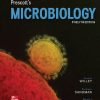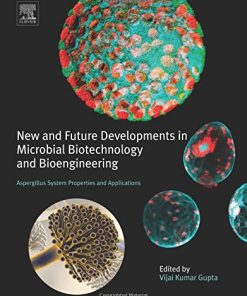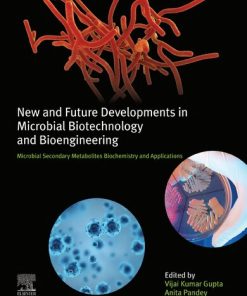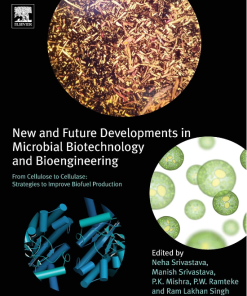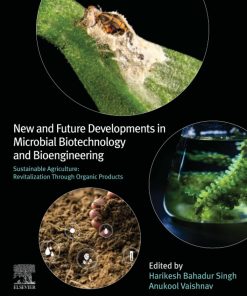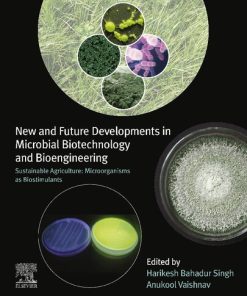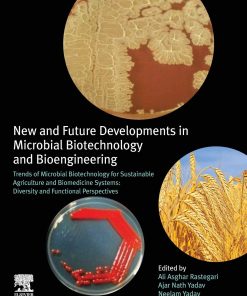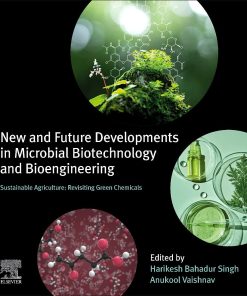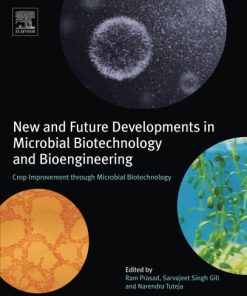New and Future Developments in Microbial Biotechnology and Bioengineering: Phytomicrobiome for Sustainable Agriculture 1st Edition by Jay Prakash Verma, Catriona Macdonald, Vijai Kumar Gupta 0444643261 9780444643261
$50.00 Original price was: $50.00.$25.00Current price is: $25.00.
New and Future Developments in Microbial Biotechnology and Bioengineering: Phytomicrobiome for Sustainable Agriculture 1st Edition by Jay Prakash Verma, Catriona Macdonald, Vijai Kumar Gupta – Ebook PDF Instant Download/DeliveryISBN: 0444643261, 9780444643261
Full download New and Future Developments in Microbial Biotechnology and Bioengineering: Phytomicrobiome for Sustainable Agriculture 1st Edition after payment.
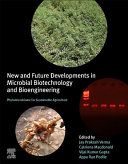
Product details:
ISBN-10 : 0444643261
ISBN-13 : 9780444643261
Author: Jay Prakash Verma, Catriona Macdonald, Vijai Kumar Gupta
New and Future Developments in Microbial Biotechnology and Bioengineering: Phytomicrobiome for Sustainable Agriculture provides a comprehensive overview of the phytomicrobiome and a holistic approach for its various mechanisms, including plant growth, nutrient content, crop yield improvement, soil fertility, and health management. This book explores the genus- and species-specific endophytic microbes for developing an efficient indigenous microbial consortium for enhancing the productivity of sustainable agriculture.
An essential resource for students, researchers, and scientists in the fields of biotechnology, microbiology, agronomy, and the plant protection sciences, New and Future Developments in Microbial Biotechnology and Bioengineering: Phytomicrobiome for Sustainable Agriculture highlights the plant growth-promoting activities of the phytomicrobiome and focuses on both its basic and applied aspects and the significant role they play in plant protection.
New and Future Developments in Microbial Biotechnology and Bioengineering: Phytomicrobiome for Sustainable Agriculture 1st Table of contents:
Chapter 1: Mechanisms of the phytomicrobiome for enhancing soil fertility and health
Introduction
The soil and plant environment as support for microbial life
Plant growth-promoting bacteria: Promotion mechanisms and application in agricultural soils
Phytomicrobiome for disease-suppressive agents
Impact of the phytomicrobiome in enhancing soil fertility, health, and plant growth attributes
Arbuscular mycorrhizal fungi and their role in plant growth in soils contaminated with heavy metals
Concluding remarks and prospects
References
Chapter 2: Impact of agrochemical application in sustainable agriculture
Introduction
Green Revolution in India and its aftermath
Agrochemicals and their applications
Agrochemicals and ecosystem health
Impact of fertilizer on aquatic health
Impact of agrochemicals on soil health
Impact of agrochemicals on greenhouse gases
Impact of agrochemicals on human health
Use of genetically modified organisms to combat agrochemical poisoning
Organic farming, an alternative to combat agrochemicals poisoning
Conclusion
References
Chapter 3: Role of plant growth-promoting rhizobacteria in degradation of xenobiotic compounds
Introduction
Plant growth-promoting rhizobacteria
Mechanisms of plant growth promotion by PGPR
Xenobiotic compounds and their hazards
Sources and examples of xenobiotic compounds
Direct sources (Varsha et al., 2011)
Indirect sources (Varsha et al., 2011)
Degradation of xenobiotic compounds by PGPR
Biodegradation
Biodegradation of pesticides
Biodegradation of plastics
Biodegradation of polychlorinated biphenyls
Biodegradation genes
Biotransformation of xenobiotics
Degradation pathways involved for xenobiotics
Genetically modified PGPR for degradation of xenobiotic compounds
Microbial enzymes in degradation of xenobiotics
Conclusions
References
Chapter 4: Seed-inhabiting endophytes: Their role in plant development and disease protection
Introduction
Seed endophytes
Seed vectored fungal endophytes
Seed vectored bacterial endophytes
Seed microbe verses rhizospheric microbe and their transmission
Seed endophytes in seedling development
Modulation of plant growth
Nutrient mobilization
Rhizophagy the way of nutrients acquisition
Seed endophytes in plant protection
Against abiotic stresses
Against biotic stresses
Conclusion
Acknowledgments
References
Chapter 5: Plant endophytic microorganisms enhancing crop productivity and yield
Introduction
Sustainable crop production and challenges
What are endophytic microorganisms
Plant invasion and colonization of endophytic microorganisms
Functions of endophytes in boosting crop production
Plant diseases and pest control
Fix atmospheric nitrogen, solubilization of soil nutrient (phosphorus, potassium, and zinc)
Production of phytohormones, metabolites, and siderophores
Contribute to plant fitness and development, for example, protection of plants against biotic and ab
Mechanisms of endophytic microbial action in plants
Conclusion and future prospects
References
Chapter 6: Arsenic-rice-human health: Understanding the toxic association from microbiome angle
Introduction
Microbial influence on arsenic cycling and metabolism
Arsenic metabolism in humans and factors influencing arsenic toxicity
The mechanisms of arsenic toxicity to humans
Arsenic and human health: Microbiome approach
Conclusions
Acknowledgment
References
Chapter 7: Emerging approaches to manipulate the plant microbiome and implications
Introduction
Modulation of soil microbiome by using crop varieties
Effect of soil texture on rhizospheric microbes
Implications of phytomicrobiome
What could be in the future
References
Chapter 8: Plant-specific microbiome for environmental stress management: Issues and challenges
Introduction
Plant-specific microbiome for enhancing sustainable agriculture
Abiotic stress
Drought stress
Salinity stress
Extreme temperature stress condition
Biotic stress
Impact of environmental stress on the plant microbiome
Remediation practices through microbiome
Issues and challenges of microbiome
Conclusion and future perspective
References
Chapter 9: Development of indigenous microbial consortium for biocontrol management
Introduction
Indigenous microorganism in agriculture
Migration of endophytes from environment to the internal tissues of plant
Mechanisms employed by microbes for plant growth
Direct mechanics of microbes in plant health
Biological nitrogen fixation
Phosphate solubilization
Phytohormone production
Indole-3-acetic acid
Cytokinin
Gibberellins
Abscisic acid
Indirect mechanics for plant growth
Siderophore production
Production of cell wall-degrading enzymes by microbes
Antibiotic production by microbes
Induction of host defense mechanisms
Microbes modulates plant stress under abiotic stress conditions
Production of 1-aminocyclopropane-1-carboxylic acid (ACC) deaminase
Consortium development
Conclusion remark and future prospective
References
Chapter 10: Plant growth-promoting rhizobacteria controlling late blight pathogen, Phytophthora infe
Introduction
Materials and methods
Isolation of bacterial isolates from potato phyllosphere and rhizosphere
Antagonistic assay of bacterial isolates against Phytophthora infestans
Assessment of plant growth-promoting determinants
Production of indole acetic acid
Assessment of siderophore production
Screening for phosphate solubilization capability
Identification of antagonistic bacterial isolates by sequencing of 16S-rDNA gene
Sequencing of purified PCR products
Analyses of nucleotide sequences
Results
Identification of antagonistic bacterial isolates to Phytophthora infestans from potato phyllosphere
Identification of bacterial isolates by sequencing of 16SrDNA
Assessment of plant growth-promoting determinants of Pseudomonas and Bacillus spp.
Assessment of indole acetic acid production
Assessment of siderophore production
Assessment of phosphate solubilization
Effect of different plant growth-promoting Pseudomonas and Bacillus spp. in increasing plant growth
Discussion
Conclusion
References
Chapter 11: Ecology and performance of rhizosphere and endosphere microbiomes
Introduction
Endophytes and their recruitment in plant tissue
The rhizosphere
Mechanisms involved in endophyte attachment and colonization
Major genes involve in endophytic colonization from rhizosphere to endosphere
Epigenetic studies on endophytic gene behavior
Horizontal and vertical transmission of endophytes
Manipulation of rhizosphere and endosphere microbiomes
Concluding remarks and future perspectives
References
Chapter 12: Plant microbe interaction for changing endophytic colonization to improve plant producti
Introduction
Endophytic colonization
Bacterial endophytes
Fungal endophytes
Arbuscular mycorrhizal fungi
Endophytic isolation and molecular characterization for making microbial inoculum
Role of endophytes in plant growth promotion
Direct mechanism of plant growth promotion
Enhancement of plant nutrient uptake
Biological nitrogen fixation
Phosphate solubilization
Siderophore production
Phytohormone production
Indole-3-acetic acid
1-Aminocyclopropane-1-carboxylate deaminase
Abiotic stress tolerance
Low-temperature tolerance
Drought tolerance
Salinity tolerance
Indirect mechanism of plant growth promotion
Biocontrol agents
Direct biocontrol mechanisms
Production of inhibitory allelochemicals
Quenching of QS in pathogenic bacteria
Indirect biocontrol mechanisms
Plant microbe interaction help to change endophytic colonization
Future prospective and challenges
Conclusion
References
Chapter 13: Role of soil microbes in biogeochemical cycle for enhancing soil fertility
Introduction
The microbial nutrient cycling the sources and its availability
Role of microbes in biogeochemical cycles
Carbon cycle
Cellulose decomposition
Hemicellulose decomposition
Lignin decomposition
Nitrogen cycle
N2 fixation
N2 fixation by free-living heterotrophs
Associative N2 fixation
Symbiotic N2 fixation
Nitrification
Denitrification
Sulfur cycle
Phosphorus cycle
Mineralization
Solubilization
Concluding remark and future prospective
References
Further reading
Chapter 14: Fungi: A potential candidate for sustainable agriculture and agroecosystem
Introduction
Endophytic fungi for sustainable agriculture
Utilization of fungal species as biofertilizer
Fungal application for inhibition of mycotoxin contamination in crop species
Mode of action and quality control for utilization of fungal species in sustainable agriculture
Conclusion
References
Chapter 15: Role of fungi in the agricultural sector and its prospects in soil restoration
Introduction
Plant growth-promoting fungi
Role and mechanisms of fungi in sustainable agriculture
Biofertilizers
Biopesticides
Bioherbicides
Role and mechanism of fungi in environmental management
Bioremediation
Biodegradation of organic compounds and inorganic compounds
Role of fungi in stress management
Abiotic stresses
Drought
Salinity
Heavy metals
Temperature (high and low)
Biotic stresses
Future perspectives and challenges
Conclusions
References
Chapter 16: Rhizosphere soil microbiomes: As driver of agriculture commodity and industrial applicat
Introduction
RSM for agricultural sustainability
Effect of plant on rhizospheric soil microbiome
Diversity of RSM
Role of RSM in soil health and plant productivity
Application of RSM for agricultural commodity
Role of RSM on nutrient acquisitions by plant
Role of RSM on plant growth under environmental stress
Application of RSM for industrial application
Role of RSM bioethanol production
Role of RSM in production of biological enzyme for industrial application
Future perspectives and challenges
Conclusion
Acknowledgment
References
Chapter 17: Plant growth promoting myco-stimulation for sustainable agriculture production under abi
Introduction
Role of mycostimulation to alleviate salinity stress
Agronomical intervention
Physiological intervention
Biochemical intervention
Molecular intervention
Role of mycostimulation to mitigate drought stress
Agronomical intervention
Physiological intervention
Biochemical processes
Molecular intervention
Role of mycostimulation to alleviate high-temperature stress
Agronomical intervention
Physiological intervention
Biochemical intervention
Molecular intervention
Role of mycostimulation to alleviate nutrient deficiency
Agronomical intervention
Physiological intervention
Biochemical intervention
Molecular intervention
Future perspectives, challenges, and limitations
Concluding remark
People also search for New and Future Developments in Microbial Biotechnology and Bioengineering: Phytomicrobiome for Sustainable Agriculture 1st:
future biotechnology examples
future developments in technology
latest developments in biotechnology
is there a future in biotechnology
new and future developments in microbial biotechnology and bioengineering
Tags: Future Developments, Microbial Biotechnology, Bioengineering: Phytomicrobiome, Sustainable Agriculture, Jay Prakash Verma, Catriona Macdonald, Vijai Kumar Gupta
You may also like…
Engineering - Bioengineering
Biology and other natural sciences - Microbiology
Biology and other natural sciences - Biotechnology
Biology and other natural sciences - Biotechnology
Biology and other natural sciences - Biotechnology
Science (General)


